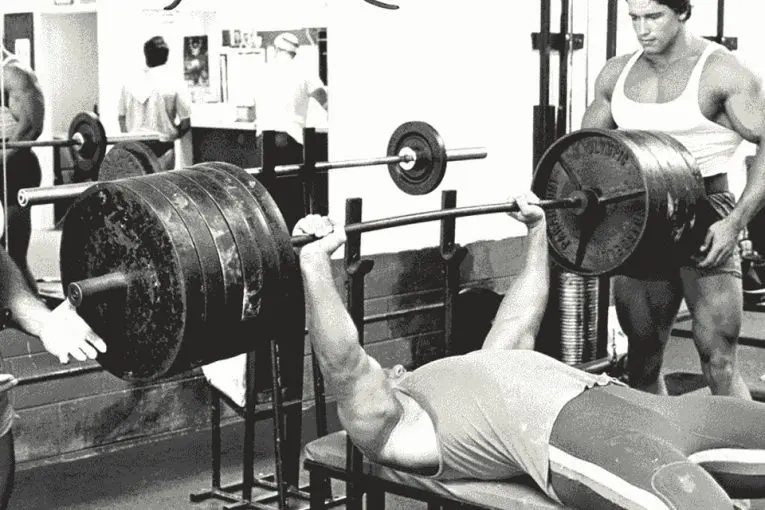Unless you use a specific training system, your workouts are probably built around a concept called straight sets. That means you do several sets with the same weight, usually aiming to do the same number of reps per set.
Each set is separated with a rest period, such as 60-90 seconds. An example of straight sets would be four sets of eight reps with 75kg.
While straight sets undoubtedly work, they do have disadvantages.
Straight Sets – The Disadvantages
When you do straight sets, your fatigue levels increase from one set to the next. This may mean that only the last set is actually intense enough to produce any results. Also, when planning a workout around straight sets, the weight used is determined by how you will feel on the last few reps of the final set. This means you may end up using weights that are too light to produce significant strength gains. Finally, when doing straight sets, you’ll need to do several sets to produce any significant muscle fatigue, and that can waste a whole lot of time.
Take a look at this example to understand more clearly why straight sets aren’t always the best training option.
Our hypothetical lifter has planned to squat 80kg for four sets of ten.
Level Up Your Fitness: Join our 💪 strong community in Fitness Volt Newsletter. Get daily inspiration, expert-backed workouts, nutrition tips, the latest in strength sports, and the support you need to reach your goals. Subscribe for free!
1stset – hit ten reps easy! Could definitely have done 3-4 more reps. This set was VERY unproductive.
2ndset – hit ten reps quite easily. Could have done another 2-3 reps. This set was also not very productive.
3rdset – just managed ten reps. Could MAYBE have got one more rep. This was a productive set.
4thset – only just hit ten reps. The last two reps were killers. Form was terrible but still managed (just!) to get all ten reps.
So, from this, we can see that only one set of the four could be called good quality training. The first two sets were little more than warm-ups, and the last set was an injury waiting to happen.
The good news is that there is another way to organize your workouts that will allow you to build muscle strength and size and make your workouts more efficient and effective – reverse pyramid training.
An Introduction to Pyramid Training
Before we lift the lid on the reverse pyramid system, we need to briefly look at the training method that spawned it – ascending pyramid training. These two methods are often confused and put under the same banner of “pyramid training.” However, they are polar opposites and should not be mixed up.
The ascending pyramid training method, also known as the light-to-heavy system, has been around for a long time. With this type of workout, you start out by doing a high rep set with a light weight, rest up for a minute or two, and then do your next set with more weight and for fewer reps.
For example:
- 12 reps with 40kg
- 10 reps with 50kg
- 8 reps with 60kg
- 6 reps with 70kg
It’s very much up to you how many sets you use for ascending pyramid training, but most lifters stick to three to five.
For best results, your ascending pyramid rep range should match your training goals. So, if you are a bodybuilder, you should stick to 6-12 reps. In contrast, if you are training for strength, your pyramid should be built around lower reps, i.e., 1-5.
Very wide rep ranges are less effective as they involve too many different intensity levels. For example, a pyramid set starting with 20 reps and ending with 3 reps would involve training in the endurance, hypertrophy, and strength rep ranges. This type of training is too general to produce good results.
Like any workout method, ascending pyramid training has pros and cons.
Ascending pyramid pros:
- Plenty of training volume, which is good for hypertrophy
- Built-in warm-up, as you start with light weights and higher reps and increase the weight set by set
- Ideal for beginners
Ascending pyramid cons:
- The first 1-2 sets may be too light to be productive
- Accumulated fatigue will limit the amount of weight you can lift toward the end of the pyramid
- Not a good method for increasing strength
- Less useful for intermediate and advanced lifters
Read also developing strength with the powerlifting bench pyramid program (with Spreadsheet)
Reverse Pyramid Training
Reverse pyramid training, also known as descending pyramids or the heavy-to-light system, takes regular pyramid training and flips it on its head. Instead of starting with a light weight for high reps, you start with your heaviest weight for lower reps.
For example:
- 6 reps with 80kg
- 8 reps with 70kg
- 10 reps with 60kg
- 12 reps with 50kg
Alternatively, if you are focused more on strength, your reverse pyramid could look like this:
- 2 reps with 140kg
- 3 reps with 125kg
- 4 reps with 110kg
- 5 reps with 100kg
As with ascending pyramids, it’s up to you how many sets you do, but three to five usually works best.
Reverse pyramid training has none of the drawbacks of ascending pyramids and several additional benefits.
When you do a reverse pyramid, you lift the heaviest weights when you are freshest. This also allows you to use heavier weights than either straight sets or the ascending pyramid method allow. This will raise the overall intensity of your workout, which will increase overload and produce better progress.
In addition, the weights decrease as fatigue accumulates. This will allow you to maintain training intensity without worrying so much about things like form breakdown or injury. The weight will be lightest when you are the most tired.
Reducing the weight set by set also has psychological benefits. It’s nice to know that you are taking weight off and not adding it on as you start to fatigue. The start of each set will feel easier than the one before, simply because it’s lighter.
Level Up Your Fitness: Join our 💪 strong community in Fitness Volt Newsletter. Get daily inspiration, expert-backed workouts, nutrition tips, the latest in strength sports, and the support you need to reach your goals. Subscribe for free!
Warming Up for Reverse Pyramid Training
The main disadvantage of reverse pyramid training is that you’ll need an extensive warm-up before starting your first set. After all, this set will be heavy, and lifting heavy weights if you aren’t warmed up properly is a good way to get injured.
The best way to prepare your muscles and joints for a reverse pyramid workout is, ironically, a modified ascending pyramid. However, unlike the standard method, you stop each set well short of failure.
For example, if your first descending pyramid set is 100kg for six reps, your warm-up might look something like this:
- 15 reps 20kg
- 10 reps 40kg
- 5 reps 60kg
- 2 reps 80kg
This will increase joint mobility and muscle temperature while simultaneously priming your nervous system for the workout to follow. But, by reducing the reps set-by-set, you can avoid accumulating unnecessary fatigue and should still feel fresh for your main workout.
How To Make Progress With Reverse Pyramid Training
Your first couple of reverse pyramid workouts should produce sufficient overload simply because it’s a new and unusual form of training. But, after those initial workouts, your body will start to get used to reverse pyramid training, and unless you find ways to make your workouts more challenging, your progress will soon stall.

There are a couple of ways you can achieve this.
Increase your weights:
This is arguably the simplest way to maintain your progress. Simply increase the weight on all your sets from one week to the next. For example:
Week one:
- 6 reps with 60kg
- 8 reps with 70kg
- 10 reps with 80kg
Week two:
- 6 reps with 65kg
- 8 reps with 75kg
- 10 reps with 85kg
Increase your reps:
This progression method is a little harder to manage as you’ll need to allocate rep ranges to your reverse pyramid. The aim is to do one more rep per set each week, and then, when you reach the upper limit of the rep range, increase the weight and drop your reps back down again.
For example:
Week 1: Set 1) 6 reps with 80kg, Set 2) 8 reps with 70kg, set 3) 10 reps with 60kg.
Week 2: Set 1) 7 reps with 80kg, Set 2) 9 reps with 70kg, set 3) 11 reps with 60kg.
Week 3: Set 1) 8 reps with 80kg, Set 2) 10 reps with 70kg, set 3) 12 reps with 60kg.
That’s the end of the prescribed rep range(s) so just increase the weight and start over.
A note on weight selection:
If reverse pyramid training has a disadvantage, it is that it takes experience and practice to choose the right weights for each set. There are no charts or apps that can tell you how much to increase the weight from one set to the next or how many more reps you should do. The reps listed in the above examples and the workout below are for guidance only and are not set in stone.
Instead of worrying about the exact weight lifted and reps performed, just stay true to the spirit of this method. Be prepared to tweak your weights and reps from one week to the next until you find your groove. So long as you take your sets to within a rep or so of failure, you’ll overload your muscles and trigger adaptations no matter how many reps you do.
Also, note that what falls perfectly into line one week could miss the mark the next. If you are particularly well-rested, you may find you perform better than expected. But, if you’re feeling tired, the opposite will be true.
Successful strength training is not always as precise as we’d like it to be. Often, simply working hard is more important than exact weight percentages or rep targets.
Sample Reverse Pyramid Training Workout
You can apply the reverse pyramid training method to most exercises, but it works best with compound moves like squats, deadlifts, bench presses, leg presses, etc. Because these exercises typically allow you to lift heavy weights, there is plenty of scope for adjusting the weights from one set to the next. This is not practical for exercises that involve light weights, as you may not be able to reduce the weight enough for this method to work.
To that end, the following workout is an upper body/lower body split where the main exercises involve a reverse pyramid, and some of the secondary exercises use the straight-set method.
Remember to warm-up to prepare your muscles and joints for what you are about to do, using a similar warm-up to the one described earlier.
Alternate between these two workouts and train 3-4 times per week. For example:
| Mon | Tue | Wed | Thu | Fri | Sat | Sun | |
| Week 1 | Upper body | Rest | Lower body | Rest | Upper body | Rest | Rest |
| Week 2 | Lower body | Rest | Upper body | Rest | Lower body | Rest | Rest |
| Or: | |||||||
| Upper body | Lower body | Rest | Upper body | Lower body | Rest | Rest | |
| Upper Body | ||||
| Exercise | Reps | Sets | Recovery | |
| 1 | Bench press | 6, 8, 10, 12 | 4 | 90 seconds |
| 2 | Pendlay rows | 6, 8, 10, 12 | 4 | 90 seconds |
| 3 | Barbell shoulder press | 8, 10, 12 | 3 | 60 seconds |
| 4 | Lat pulldowns | 8, 10, 12 | 3 | 60 seconds |
| 5 | Lateral raises | 12 | 3 | 60 seconds |
| 6 | Pullovers | 12 | 3 | 60 seconds |
| 7 | Barbell curls | 8, 10, 12 | 3 | 60 seconds |
| 8 | Skull crushers | 8, 10, 12 | 3 | 60 seconds |
| Lower Body | ||||
| Exercise | Reps | Sets | Recovery | |
| 1 | Squats | 6, 8, 10, 12 | 4 | 90 seconds |
| 2 | Romanian deadlifts | 8, 10, 12 | 3 | 90 seconds |
| 3 | Lunges | 12 per leg | 3 | 60 seconds |
| 4 | Leg extensions | 12, 10, 8 | 3 | 60 seconds |
| 5 | Leg curls | 12, 10, 8 | 3 | 60 seconds |
| 6 | Standing calf raises | 12, 10, 8 | 3 | 60 seconds |
| 7 | Cable crunches | 15 | 3 | 60 seconds |
| 8 | Dumbbell side bends | 12 per side | 3 | 60 seconds |
Reverse Pyramid Training – Wrapping Up
Reverse pyramid training is an effective way to build strength and muscle size. It overcomes many of the disadvantages of both straight sets and ascending pyramids, and as such, it’s a valuable addition to your training toolbox.
Does that mean it’s the one and only training method you should use? Absolutely not!
It’s just one of several workout options you have available to you. Plus, if you use this method too often or for too long, like any training system, it will start to become less effective.
If you have been using straight sets for more than a few months, your body will probably be ready for something new. Try reverse pyramid training for your next cycle of workouts. It could be the shot in the arm you need to maintain your progress.













